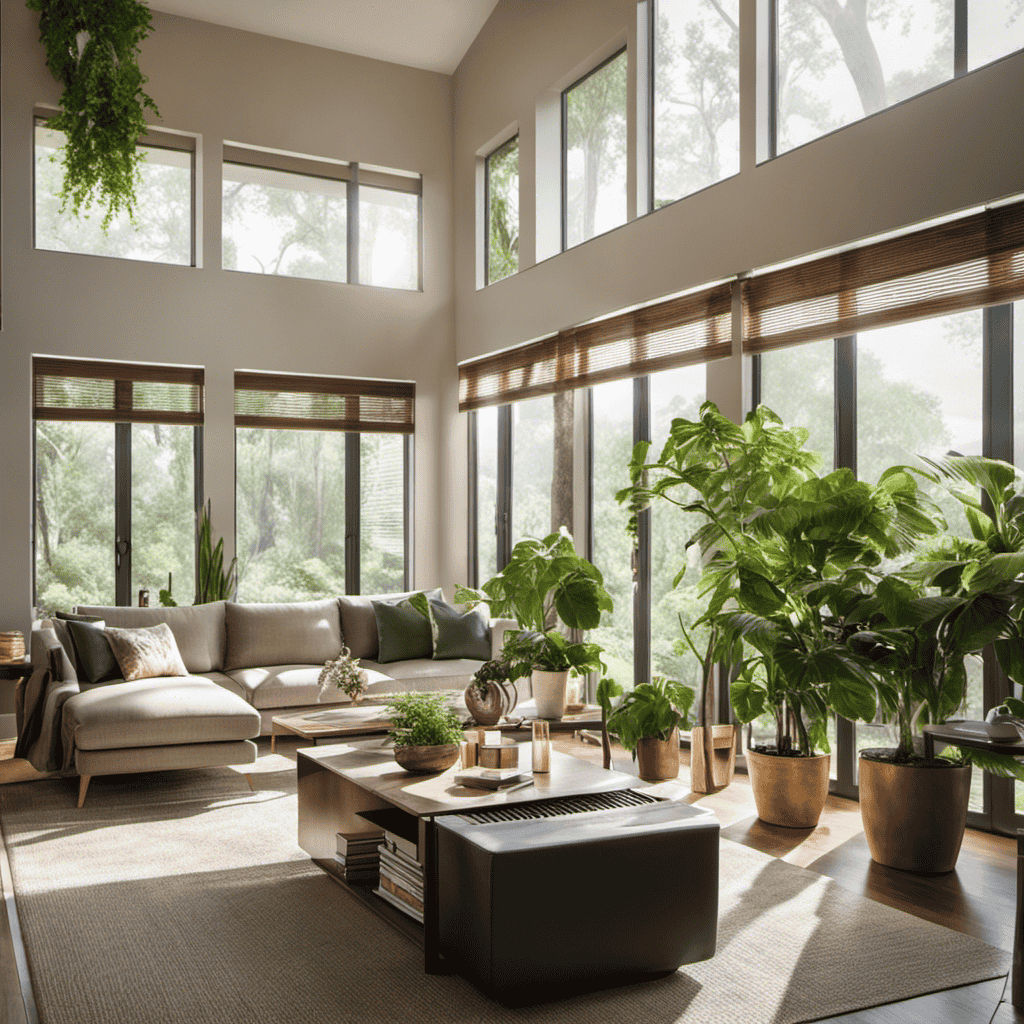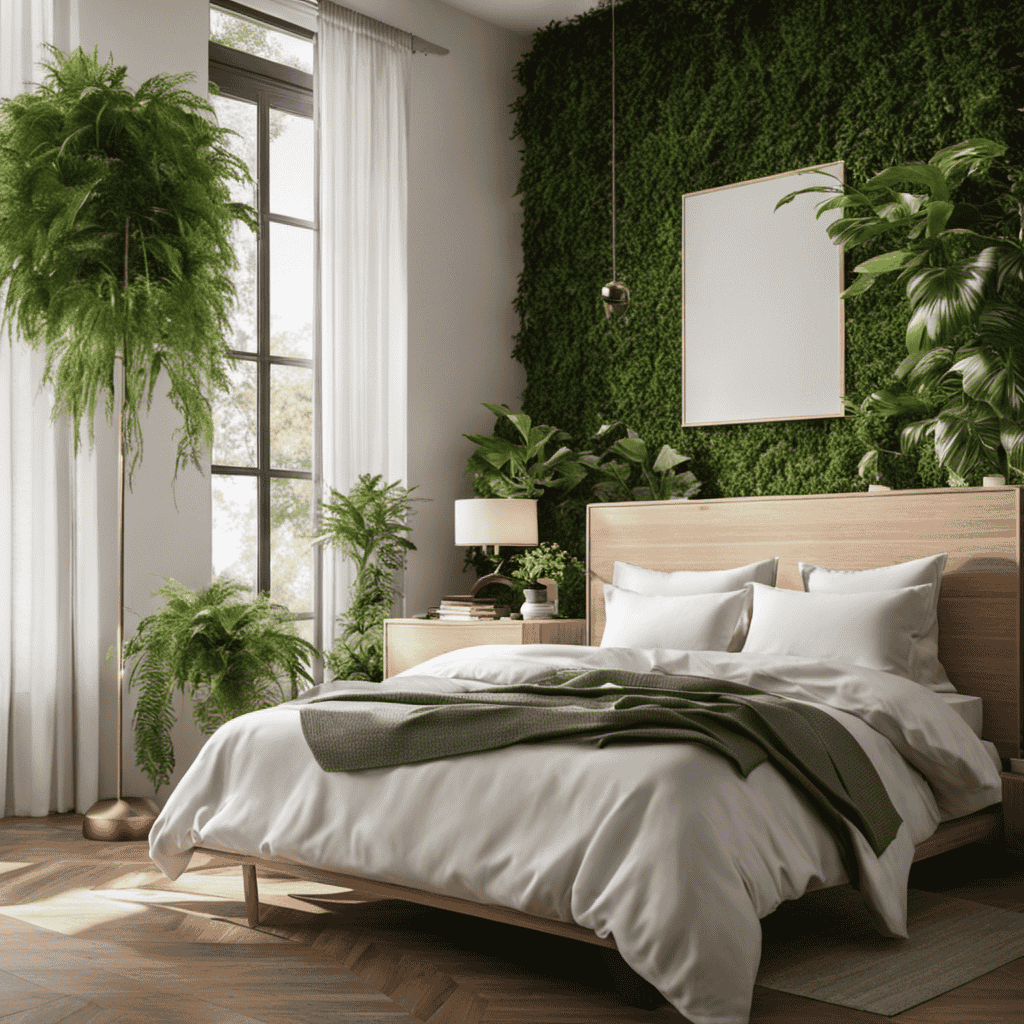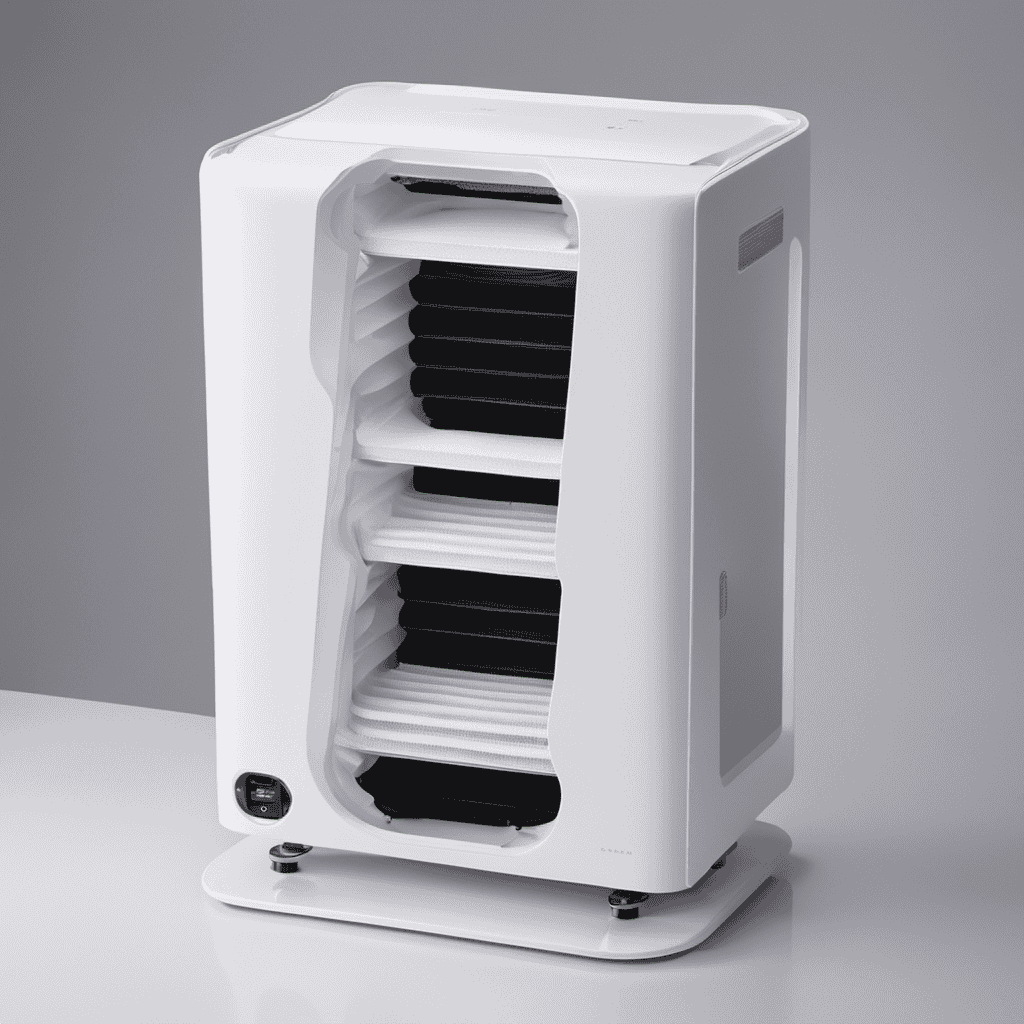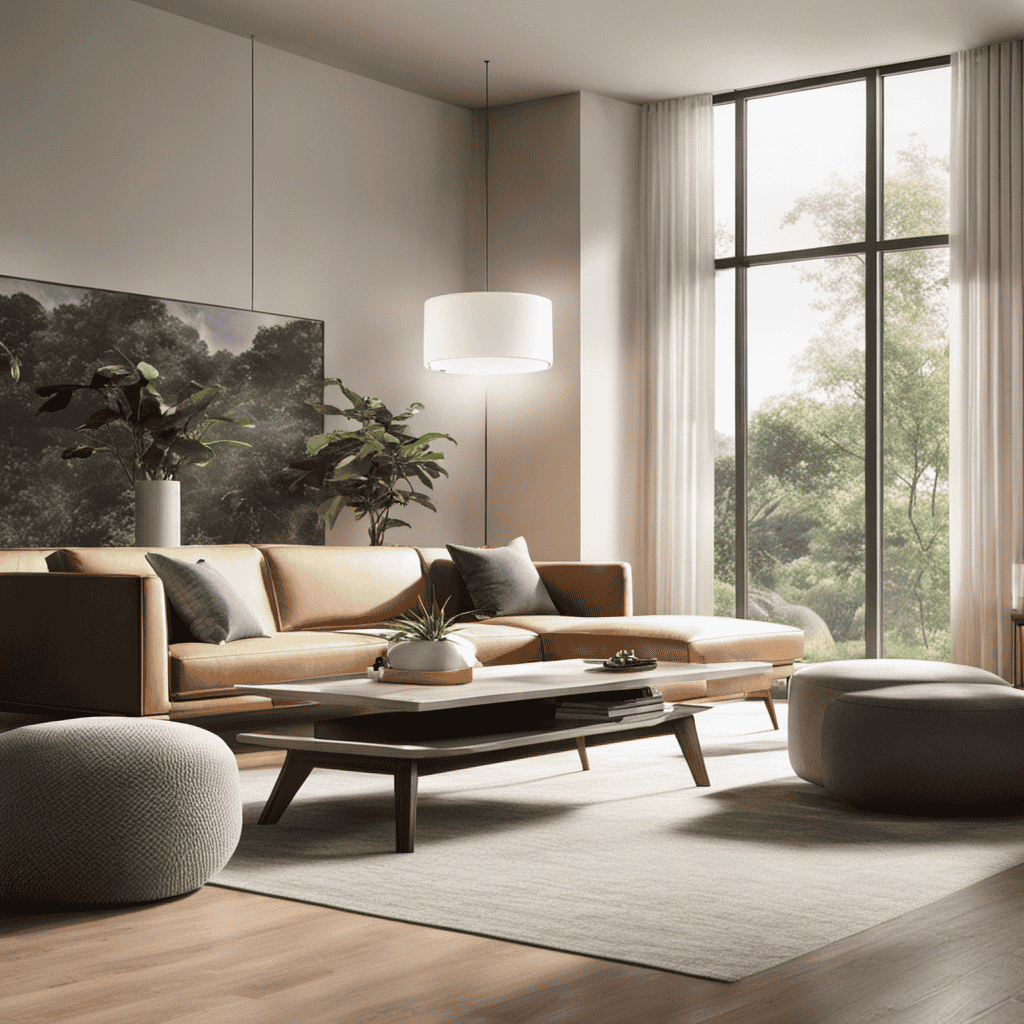I have a fascinating tale to share with you about air purifiers. These handy gadgets have been generating a lot of attention recently.
You see, air purifiers are designed to clean the air we breathe, removing all sorts of nasty contaminants that can harm our health. But here’s the kicker – not all air purifiers are created equal.
There are different types, different filters, and different factors to consider when choosing one. So, buckle up and get ready to dive into the world of air purifiers. Trust me, you’ll want to know all about them.
Key Takeaways
- Air purifiers reduce allergens and improve indoor air quality.
- Different types of air purifiers use various filter types, each with its own advantages and disadvantages.
- Air purifiers work by using a multi-stage filtration process to capture even the smallest particles, promoting better health and well-being.
- Factors to consider when choosing an air purifier include the effectiveness of the filter type, room size suitability, and the MERV rating of the filter.
Benefits of Using an Air Purifier
Using an air purifier can help reduce allergens and improve indoor air quality. Air purifiers are especially beneficial for individuals with allergies and those who have pets. These devices work by filtering out airborne particles such as pollen, pet dander, dust mites, and mold spores, which are common triggers for allergies.
By removing these allergens from the air, air purifiers can help alleviate symptoms like sneezing, coughing, and itchy eyes. Additionally, air purifiers designed specifically for pets can also capture pet hair and odors, providing relief for pet owners who may experience allergic reactions or unpleasant smells.
With advanced filtration systems and technologies, air purifiers offer an effective solution to create a cleaner and healthier indoor environment, making them an essential tool for allergy sufferers and pet owners alike.
Types of Air Purifiers
When it comes to air purifiers, one important aspect to consider is the type of filter used. There are several different filter types available, such as HEPA filters, activated carbon filters, and ionizers.
Each filter type has its own advantages and disadvantages in terms of their ability to remove different types of pollutants from the air.
Additionally, the performance of air purifiers can vary depending on the size of the space they are being used in. Factors like room size, ceiling height, and airflow can all impact how effectively an air purifier can clean the air in a given space.
Filter Types Comparison
There’s a wide range of filter types available for air purifiers, each with its own advantages and disadvantages.
When it comes to air purifier maintenance, it is important to consider the type of filter used. Some filters, like HEPA filters, require regular replacement to ensure optimal performance. On the other hand, washable filters can be cleaned and reused, reducing the need for frequent replacements.
Another factor to consider is air purifier noise levels. Some filters, like activated carbon filters, are known to operate quietly, while others, such as ionizers, may produce a noticeable buzzing sound. It is crucial to find a balance between effective filtration and acceptable noise levels.
Moving forward, let’s explore how different filter types perform in various spaces.
Performance in Different Spaces
For optimal performance in different spaces, consider which filter type will best meet your specific needs. When it comes to air purifiers, performance analysis and case studies have shown that different filter types excel in different environments. Here is a comparison table that highlights the key features and benefits of the most common filter types:
| Filter Type | Key Features | Benefits |
|---|---|---|
| HEPA | Captures 99.97% of particles as small as 0.3 microns | Effective against allergens, dust, and pet dander |
| Activated Carbon | Absorbs odors and harmful gases | Great for removing smoke and chemical fumes |
| UV-C | Destroys germs and bacteria | Ideal for sterilizing the air in hospitals and clinics |
| Ionizer | Releases negative ions to neutralize pollutants | Helps eliminate airborne particles and improve overall air quality |
How Does an Air Purifier Work
When it comes to understanding how an air purifier works, it’s essential to delve into the filtration process. The filtration process is the key mechanism that these devices use to remove pollutants and impurities from the air.
There are different types of air purifiers available in the market, each employing a specific filtration method to achieve clean and purified air.
Filtration Process Explained
The air purifier uses a multi-stage filtration process to remove harmful particles from the air. One of the most important components of this process is the HEPA filter, which stands for High Efficiency Particulate Air filter. HEPA filters are designed to capture even the smallest particles, including dust, pollen, pet dander, and even some bacteria and viruses. This is why air purifiers with HEPA filters are highly recommended for individuals with allergies or respiratory conditions.
The benefits of using HEPA filters in air purifiers are numerous. These filters can improve indoor air quality by reducing the levels of airborne pollutants, which in turn can alleviate symptoms such as sneezing, coughing, and itchy eyes. HEPA filters also help remove harmful substances like smoke, volatile organic compounds (VOCs), and mold spores from the air, providing a healthier and cleaner environment.
Maintaining good air quality is of utmost importance, as poor air quality can lead to various health problems, ranging from allergies and asthma to more serious conditions like cardiovascular disease and respiratory infections. By using air purifiers with HEPA filters, we can significantly reduce the presence of harmful particles in the air we breathe, promoting better overall health and well-being.
Types of Air Purifiers
One popular type of air purifier is the activated carbon filter. It effectively removes odors and harmful gases from the air by trapping and absorbing airborne pollutants. This type of filter is made up of tiny pores.
Here are some key points to consider when comparing air purifier brands and their cost:
- Different brands offer various levels of activated carbon filtration. Some brands also incorporate additional technologies such as HEPA filters or ionizers.
- Prices for air purifiers can vary greatly depending on the brand, features, and coverage area.
- It is important to consider long-term costs, such as replacement filters and energy consumption.
- Some brands may offer additional warranties or customer support, which can influence the overall value.
- Reading customer reviews and considering expert recommendations can help in making an informed decision.
With this understanding of air purifier brands and cost comparison, it is important to explore the common contaminants that these devices can effectively remove from the air.
Common Contaminants Removed by Air Purifiers
Common contaminants that are typically removed by air purifiers include dust, pollen, pet dander, and mold spores. Air purifiers are designed to capture and eliminate these particles from the air, providing a cleaner and healthier environment.
When it comes to removing pet dander, air purifiers with HEPA filters are highly effective. These filters are capable of trapping tiny particles, such as pet dander, preventing them from circulating in the air.
Additionally, air purifiers can also help eliminate smoke particles. Smoke particles are small and can linger in the air for long periods of time, but with the use of activated carbon filters, air purifiers can effectively remove these particles, reducing the smell and improving the indoor air quality.
Considering the importance of removing pet dander and smoke particles, it is crucial to consider these factors when choosing an air purifier.
Factors to Consider When Choosing an Air Purifier
When choosing an air purifier, it’s important to consider the effectiveness of the filter type and its suitability for the size of the room.
The effectiveness of the filter type determines how efficiently the purifier can remove contaminants from the air. This is crucial because the main purpose of an air purifier is to improve indoor air quality by eliminating pollutants.
On the other hand, the room size suitability ensures that the purifier can adequately clean the air in the designated space. If the purifier is too small for the room, it may not be able to effectively circulate and filter the air. Conversely, if the purifier is too large for the room, it may consume unnecessary energy and be less efficient.
Considering these factors is essential because they play a crucial role in determining the overall performance and effectiveness of the air purifier. By choosing a purifier with the right filter type and suitable for the room size, you can ensure that it effectively cleans the air and improves indoor air quality.
Filter Type Effectiveness
You can easily determine the effectiveness of the air purifier’s filter type by checking its MERV rating. The MERV rating, or Minimum Efficiency Reporting Value, indicates how well the filter can capture airborne particles. A higher MERV rating means a more efficient filter that can remove smaller particles from the air.
When it comes to improving indoor air quality and reducing indoor pollutants, choosing an air purifier with a high MERV rating is essential. Here are five reasons why:
- Higher MERV rating filters can capture smaller particles like allergens and dust mites.
- They can effectively remove pet dander and pollen from the air.
- Air purifiers with high MERV ratings can also trap mold spores and bacteria.
- They can significantly reduce the presence of harmful volatile organic compounds (VOCs) in the air.
- By choosing an air purifier with a high MERV rating, you can ensure that the air in your home is cleaner and healthier to breathe.
Considering the importance of air quality improvement, it is crucial to also consider the suitability of the air purifier for the room size.
Room Size Suitability
To determine if the air purifier is suitable for your room size, measure the square footage and compare it to the recommended coverage area. Room size limitations play a crucial role in ensuring optimal air purification.
Air purifiers are designed to effectively clean the air within a specific area, and exceeding their recommended coverage area may result in decreased efficiency. When considering an air purifier, it is important to assess the size of your room and choose a purifier that matches or slightly exceeds the square footage.
Additionally, air purifier placement is another factor to consider for maximum effectiveness. Placing the purifier in a central location within the room allows for efficient distribution of clean air throughout the space, ensuring that every corner is effectively purified.
Tips for Maintaining an Air Purifier
Regularly cleaning the filters is essential for keeping your air purifier in optimal condition. Dust, allergens, and other particles can build up on the filters, reducing their effectiveness and potentially causing the air purifier to malfunction. Here are some air purifier maintenance tips to ensure your device works efficiently:
- Clean or replace the filters according to the manufacturer’s instructions.
- Check and clean the pre-filter regularly to prevent clogging.
- Keep the air purifier in a well-ventilated area to prevent overheating.
- Use a soft cloth or brush to clean the exterior of the device.
- Perform regular troubleshooting to address common air purifier issues, such as unusual noise or weak airflow.
By following these maintenance tips, you can prolong the lifespan of your air purifier and ensure that it continues to provide clean and healthy air for you and your family.
Transitioning into the subsequent section about the health effects of poor air quality, it is important to understand the impact of neglecting air purification in maintaining good indoor air quality.
Health Effects of Poor Air Quality
Neglecting proper air purification can lead to various health issues caused by poor air quality, such as respiratory problems and allergies.
Air pollution is a major contributor to these health effects. Particulate matter, volatile organic compounds (VOCs), and other pollutants present in the air can irritate the respiratory system and cause inflammation.
Prolonged exposure to polluted air can increase the risk of developing respiratory diseases such as asthma, bronchitis, and chronic obstructive pulmonary disease (COPD). These conditions can cause symptoms like coughing, wheezing, shortness of breath, and chest tightness.
Additionally, poor air quality can trigger allergies, leading to symptoms like sneezing, itchy eyes, and a runny nose.
Therefore, ensuring proper air purification is crucial in maintaining good indoor air quality and reducing the risk of respiratory diseases caused by air pollution.
Air Purifiers Vs. Other Indoor Air Quality Solutions
If you’re considering other indoor air quality solutions, it’s important to weigh the benefits and drawbacks of each option. When comparing air purifiers to plants, there are some key points to consider:
-
Air purifiers have the advantage of being able to filter out a wide range of pollutants, including allergens, dust, and smoke.
-
Plants, on the other hand, can help improve air quality by absorbing carbon dioxide and releasing oxygen through photosynthesis.
-
Air purifiers are more effective at removing harmful particles from the air, while plants mainly improve air quality by increasing humidity and reducing toxins.
-
When comparing air purifiers to ventilation systems, it’s important to note that air purifiers can be more targeted in removing specific pollutants, whereas ventilation systems simply circulate air.
-
Ventilation systems, however, can help remove stale air and bring in fresh air from outside, which can be beneficial in reducing indoor air pollution.
Ultimately, the choice between air purifiers, plants, and ventilation systems depends on the specific air quality issues you are trying to address.
Do Air Purifiers Really Work
When it comes to improving indoor air quality, it’s important to understand if air purifiers really work.
Scientific studies on air purifiers have been conducted to determine their effectiveness in removing pollutants from the air. These studies have shown that air purifiers can indeed help improve indoor air quality by reducing the levels of airborne particles, such as dust, pollen, and pet dander. They can also be effective in removing certain gases and odors from the air.
However, it’s important to note that the effectiveness of air purifiers can vary depending on factors such as the size of the room, the type of pollutants present, and the specific model of the air purifier. Therefore, it’s recommended to choose an air purifier that is suitable for your specific needs and to follow the manufacturer’s instructions for optimal performance.
Understanding Air Purifier Filters
To better understand the filters in your air purifier, it’s important to know how they work and what role they play in improving indoor air quality. Air purifier filters are designed to capture and remove airborne particles such as dust, pollen, pet dander, and smoke. They work by trapping these particles as air passes through the filter, preventing them from circulating in the room.
Here are five key points to consider about air purifier filters:
- Filters should be regularly cleaned or replaced to maintain their efficiency.
- Different types of filters target specific pollutants, so it’s essential to choose the right one for your needs.
- High-quality filters can capture even the smallest particles, improving the overall air quality in your home.
- Filters also help reduce odors by trapping odor-causing particles.
- Regular maintenance of your air purifier and its filters will ensure optimal performance and prolong the lifespan of the device.
Understanding the importance of clean air and maintaining your air purifier filters is crucial for creating a healthier indoor environment.
Frequently Asked Questions
Can Air Purifiers Eliminate All Types of Odors in a Room?
Yes, air purifiers can effectively eliminate many types of odors in a room. However, their effectiveness may vary depending on factors such as the size of the room, the type of odor, and the maintenance of the air purifier.
Are Air Purifiers Noisy When They Are in Operation?
Are air purifiers noisy when they’re in operation? Yes, some can be noisy, but modern models are designed to minimize noise. Air purifiers are effective at removing pollutants and allergens, and their energy consumption varies depending on the model.
Can Air Purifiers Help With Allergies Caused by Pet Dander?
Air purifiers can be effective in reducing allergies caused by pet dander. The best air purifiers for pet allergies have HEPA filters that can capture tiny particles, including pet dander, and help improve indoor air quality.
Do Air Purifiers Remove Bacteria and Viruses From the Air?
Yes, air purifiers can effectively remove bacteria and viruses from the air. With advanced air purifier technology, they use filters, such as HEPA filters, to capture and trap these microorganisms, improving indoor air quality.
Can Air Purifiers Reduce the Risk of Respiratory Illnesses Like Asthma and Bronchitis?
Yes, air purifiers can reduce the risk of respiratory illnesses like asthma and bronchitis by improving air quality. They are effective in removing pollutants, allergens, and irritants from the air, which can alleviate symptoms and promote better respiratory health.
Conclusion
In conclusion, air purifiers are highly effective in improving indoor air quality and reducing the presence of contaminants.
With different types of air purifiers available, it is important to consider factors such as room size and specific air quality concerns when choosing the right one.
Studies have shown that air purifiers can provide relief for individuals with respiratory conditions or allergies. For instance, a case study conducted on a family with severe asthma demonstrated significant improvement in their symptoms after using an air purifier consistently for a month.
Therefore, investing in an air purifier can greatly benefit your health and well-being.










